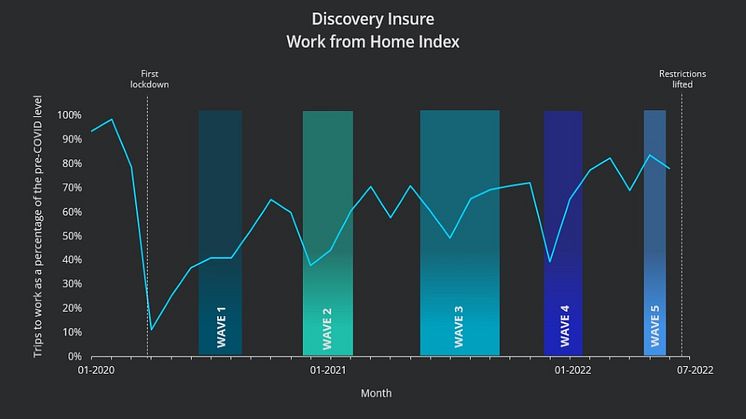
Press release -
SA’s most popular days for driving to work are Tuesdays and Wednesdays, according to recently released driving data
Discovery Insure’s new Work From Home Index has revealed an average of three days per week that people are physically travelling between work and home. These are the two most common destinations between which many people travel – often more than once a week – ordinarily every week.
During the past two years, our movement patterns between these two destinations have shifted and Discovery Insure has had their “eyes” on this evolution since the onset of the COVID-19 lockdowns at the end of March 2020.
COVID-19 waves brought a change in movement patterns
“Our analytics team has watched with keen interest as people changed their movement patterns during COVID-19 in line with the peaks and dips of the infectious waves we experienced,” says Discovery Insure Chief Executive, Anton Ossip.
“Our interest isn’t at all random or purely for curiosity’s sake. As an insurer seeking to protect our clients from risk, it is important to understand how these risks are changing or emerging over time and how this impacts our clients,” he adds. “To understand these patterns, we developed the Work From Home Index, which uses our market-leading telematics driving data to look at how our clients have shifted from ‘working predominantly from home’ to ‘returning to work’ locations.”
Ossip explains that the starting data point for the Index was a pre-COVID baseline set in February 2020 – the month before the first officially diagnosed case in South Africa and just prior to the subsequent level five, hard lockdown.
How does the Work From Home Index measure destinations and driving trends?
“The two dominant destinations on which to base our measurements were intuitive – an individual’s home and their work environment. Here we could compare detailed location data,” says Ossip. “A ‘home’ location was determined as being the place where our clients spent the night hours of most weekdays. This was also based on the end location of their last driving trip for each day.”
He explained that the team then defined a ‘work’ location as one that had a driving trip link to a specific location and back home again within a day.
“To define these ‘work’ trips, we needed to identify certain criteria that made sense. For example, a client would need to have left their home in the morning on a weekday to go to ‘work’ at some other location, where they would then have stayed for a number of hours, before returning home by the end of the day.”
Index findings reveal a stark contrast between ‘home’ vs ‘work’ travels in hard lockdown compared to present day
“Our data team has graphically represented the ‘work’ and ‘home’ trends, and findings reveal that during the last couple months of this year, around 80% of people are now working at their ‘work’ locations again, compared to data on the pre-COVID levels,” says Ossip. “By contrast, people were most certainly home-based between March and May 2020, correlating directly with the initial hard lockdown.”
“The graph also clearly highlights a decrease in the number of individuals travelling to work during the various lockdown periods where COVID-19 peaked, with the virus being more virulent and infectious during these times. It is interesting to see how these increased again very quickly once waves dissipated. Again, this is intuitive,” continues Ossip.
He also notes how the graph continues its trend upwards following the initial hard lockdown dip in April / May 2020.
“We believe this continued ascent distinctly illustrates the resilient nature of our population, which could also have been influenced by individuals getting vaccinated during the second half of 2021,” Ossip explains.
Newfound freedom in hybrid working during 2022
“In terms of patterns observed more recently from our data, the Work From Home Index reveals a newfound sense of ‘freedom’ so far this year,” says Ossip. “People are now able to choose where and when they go into work in the instances of highly infectious waves of COVID being recorded.”
So what patterns are currently in motion?
- A large percentage of Discovery Insure clients are not going into ‘work’ consistently on the same days each week. This points to a changed pattern of expectations whereby more workers are enjoying increased levels of flexibility in their workday.
- The number of days that people travel to work varies:
- The average number of days people are going into ‘work’ is three days per week.
- The proportion of people going into ‘work’ three or more days in a week is 10% less than pre-COVID levels.
- The proportion of people going into ‘work’ every day during the week is 20% less than pre-COVID levels.
- The most popular days for traveling to work appear to be Tuesdays and Wednesdays. The least favoured day is a Friday, with around 20% fewer trips recorded on that day.
“Discovery Insure is in a unique position to assess work-from-home versus return-to-work patterns based on our telematics driving data,” says Ossip. “The changes we have seen in movement patterns indicate that South Africans are not just resilient, they are also hardworking and have adapted as required during this pandemic. It is also interesting to see how external factors such as loadshedding and fuel price increases will likely have an impact here, with loadshedding making it difficult for some to work from home while on the other hand fuel price increases (up 53% over the past 12 months) makes it more expensive to travel to work. Regardless, there is definitely a strong sense of people returning to a ‘pre-COVID normal’.”
The insights from Discovery Insure’s driving data also mirrors global trends of increased flexibility in other countries.
“This is one thing that COVID-19 has re-shaped for the working world! By continuing to monitor this index, we will be able to assess which shifts and changes are likely to have a long-term impact on how people work, such as the hybrid working model – something that Discovery has embraced too. We’ll be able to monitor whether a hybrid approach will indeed become the new normal going forward. It’s exciting to see a robust society from our data and we look forward to observing how things will adapt during the second half of this year,” Ossip concludes.
Ends/.
Note to editors: The above graph depicts driving patterns starting from a pre-COVID period at the beginning of 2020, until the month of June 2022. Shaded sections highlight the various waves of the pandemic. The trendline of the graph indicates the number of trips Discovery Insure clients are making to their ‘work’ locations, as a percentage of pre-COVID levels, over time. The movement of the graph indicates changes in the number of these trips to ‘work’, correlating with the peaks and dips of the COVID-19 waves experienced in South Africa and/or various lockdown stages. These dips indicate a high number of individuals opting to rather ‘work from home’.
Topics
Discovery information
About Discovery
Discovery Limited is a South African-founded financial services organisation that operates in the healthcare, life assurance, short-term insurance, banking, savings and investment and wellness markets. Since inception in 1992, Discovery has been guided by a clear core purpose – to make people healthier and to enhance and protect their lives. This has manifested in its globally recognised Vitality Shared-Value insurance model, active in over 35 markets with over 20 million members. The model is exported and scaled through the Global Vitality Network, an alliance of some of the largest insurers across key markets including AIA (Asia), Ping An (China), Generali (Europe), Sumitomo (Japan), John Hancock (US), Manulife (Canada) and Vitality Life & Health (UK, wholly owned). Discovery trades on the Johannesburg Securities Exchange as DSY.
Follow us on Twitter @Discovery_SA








